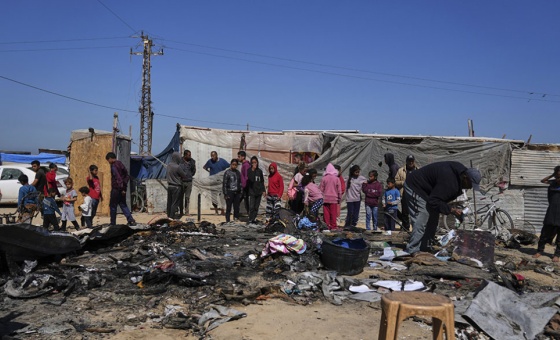This is the last article you can read this month
You can read more article this month
You can read more articles this month
Sorry your limit is up for this month
Reset on:
Please help support the Morning Star by subscribing here
IN HIS first term as US president, Donald Trump tore up the Joint Comprehensive Plan of Action, which had been agreed by Barack Obama in 2015, primarily to constrain Iran’s uranium enrichment programme in exchange for some sanctions relief.
For Trump, this was simply a case of Obama being “soft” on Iran, and from 2018 a policy of “maximum pressure” was adopted towards Iran, with any compromise or negotiation off the table.
The Biden administration did not fundamentally change this approach, and to all intents and purposes, foreign policy under Biden was a continuation of that under Trump in relation to Iran.
Iran’s adventurist foreign policy, regarding its support for Hamas, Hezbollah, and the Houthis in Yemen under the banner of the Axis of Resistance, has exacerbated relations with Israel (already in a parlous state) and provided the West with an excuse to maintain sanctions, which are crippling the Iranian economy and impoverishing its people.
The October 7 2023 action by Hamas has brought the prospect of a broader conflict in the Middle East closer to reality, due to the overwhelming genocidal response by Israel in Gaza. Any such conflict, with Iran and Israel as the main protagonists, would be disastrous for the people of the region and potentially threaten world peace, given the allegiance of the US to Israel and the ties Iran has with both Russia and China.
In his second term in office, President Trump has moved quickly to address relations with Iran, having sent a letter to Supreme Leader Ayatollah Ali Khamenei earlier this month. The contents of the letter have not been shared publicly, but it is widely believed that it gives Iran a two-month deadline to either come to the negotiating table or be subject to military action.
While not officially confirmed, this position has been broadly endorsed by Trump in subsequent interviews. Last week, Iran’s Foreign Minister, Abbas Araghchi, was quoted as saying that a response to Trump’s letter has been “appropriately sent through Oman.”
Araghchi is further quoted by the official Iranian news agency, as saying: “Our policy is still not to engage in direct negotiations while under maximum pressure and military threats. However, as was the case in the past, indirect negotiations can continue. Our response includes a letter in which we detailed our views on the current situation and Mr Trump’s letter.”
While Iran may grandstand to impress its regional allies, it remains in a relatively weak position. Although a strategic partnership treaty was signed with Russia in January, it does not obligate either side to support the other if under military attack — only an agreement not to help any country that attacked the other.
The so-called Axis of Resistance has been significantly weakened by the actions of the Israeli Defence Force. The demise of the Assad regime in Syria has robbed Iran of a key regional ally. Close relations with China, based upon a 25-year agreement signed in March 2021, do not imply any military support and have yet to yield any significant boost to the Iranian economy.
While links with Russia and China can by no means be dismissed — and a direct attack upon Iran could change the dynamics of those alliances — the Iranian regime cannot expect military support as a matter of course.
Added to the relative isolation of Iran on the international stage is the growing internal pressure, arising from the economic crisis resulting from sanctions, endemic corruption, and economic mismanagement. Increased production was once again a theme of Khamenei’s address to mark the Iranian new year in March, but this has been rhetoric from the dictatorship for many years, without any significant investment or strategy for increased industrial production materialising.
International sanctions continue to be a heavy burden upon the Iranian economy and the working people of Iran. This has resulted in increasing economic disparity in the country, as a minority are able to enrich themselves through government-linked contracts while the majority suffer the consequences of rampant inflation, poverty and insecure employment.
The desperate economic situation has even forced the government to make some concessions on social issues to try and appease an increasingly restless population. The lifting of former presidential challenger Mehdi Karroubi’s house arrest and the suspension of the announcement and implementation of the Hijab and Chastity Law are examples of these retreats.
Mohammad Bagher Ghalibaf, the speaker of parliament, recently wrote on X: “In the current Hijab and Chastity Law, the Guidance Patrol has been completely removed. The announcement of the current law […] has been suspended.”
There can be little doubt that the Women, Life, Freedom movement, which has rocked the Islamic Republic of Iran since the murder in detention of Mahsa Amini in September 2022, has played a huge part in wringing concessions from the regime.
Young women have very much spearheaded the movement, which has actively challenged the theocracy. More than 600 activists were shot in the streets or were executed at the height of protests, but the regime has had to back down and accept that women have the right to decide what to wear.
These examples demonstrate that public pressure and the government’s unstable position vis-a-vis the people can result in concessions, showing that even in a religious dictatorship, the government can be forced to retreat in the face of public demands. Until recently, hardliners in Iran were insisting on confronting women who uncover their hair.
The process of Khamenei’s personal credibility being eroded, and his decisions as Supreme Leader being questioned in public opinion, has clearly accelerated. Khamenei’s — and the regime’s — inability to resolve the country’s crises is becoming increasingly clear. It is widely held that the government itself, and Khamenei at its head, are the main cause of the current crises, which have deprived a large part of society, especially working people, of the right to welfare and a decent life.
The continuation of popular protests in various forms over the past two years, despite all the regime’s pressures and crackdowns, demonstrates that the clerical regime has a narrow social base — estimated at around 20 per cent maximum. The regime remains incapable of resolving its deep political and economic crises. Through continued and expanding struggle, the progressive opposition in Iran believes that the regime can be forced to further retreat.
Pressure from workers and trade unions continues to be key to the struggle in Iran. The Committee for the Defence of Iranian People’s Rights has learned from trade union activists in Iran that the regime, through its harsh sentences on teachers’ union activists, aims to make an example of them and send out a message that it simply will not tolerate any activity even resembling organised opposition in the country.
The reality is that the theocratic regime is flying in the face of history, and growing dissent will lead to change in Iran. However the “indirect” negotiations with the US play out, it is the Iranian people who must ultimately decide their own destiny. There is every indication that they are mobilising to do that.
Steve Bishop is a senior member of the executive committee of the Committee for the Defence of Iranian People’s Rights. For information on Iran and Codir, visit www.codir.net.







